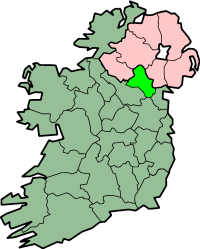County Monaghan
| County Monaghan Contae Mhuineacháin |
||
| Location | ||
|
||
| Statistics | ||
| Province: | Ulster | |
| County seat: | Monaghan | |
| Code: | MN | |
| Area: | 1,294 km² | |
|
Population (2006[1]) |
55,816 | |
| Website: www.monaghan.ie | ||
County Monaghan (IPA: /'mɔnəhən/; Irish: Contae Mhuineacháin) is a county in Ireland. It is one of three counties situated in the province of Ulster which are in the Republic of Ireland. The name comes from the Irish, derived from Muine Cheain meaning the Land of the little hills. This name refers to the density of drumlins in the area, those small hills formed from glacial action (during a previous ice age).
The county borders County Tyrone (Northern Ireland) to the north, County Armagh (NI) to the east, County Louth (Republic of Ireland) to the southeast, County Meath (ROI) to the south, County Cavan (ROI) to the southwest and County Fermanagh (NI) to the west.
There is a pene-enclave jutting into Fermanagh in the western area of the county.
Monaghan is the principal town. Other major towns include Carrickmacross, Castleblayney, and Clones.
Monaghan is the birthplace of the poet and writer Patrick Kavanagh, who based much of his work in the county. Kavanagh is one of the most significant figures in mid 20th century Irish Poetry. The poems Stony Grey Soil and Shancoduff refer to the county.
Contents |
History
In 1585, Sir John Perrot, the natural son of King Henry VIII, visited the area and met with the Irish chieftains. They requested that Ulster be divided into counties and land in the kingdom of Airgíalla be apportioned to each of the McMahon chiefs. A commission was established to accomplish this and County Monaghan came into being. The County was subdivided into the five baronies that exist today: Farney, Cremorne, Dartrey, Monaghan, and Truagh.
After the defeat of the rebellion of Hugh O'Neill, The O'Neill and the Ulster chieftains in 1603, the county was not planted like the other counties of Ulster. The lands were instead left in the hands of the native chieftains. In the Irish Rebellion of 1641 the McMahons and their allies joined the general rebellion of Irish Catholics, and following their defeat there was some plantation of the county with Scottish and English families.
Twinning
County Monaghan is twinned with the Province of Prince Edward Island in Canada. At least 20% of the population of Prince Edward Island can trace ancestry to Co Monaghan as a result of migration from Monaghan to that part of Canada during the years 1820-1840. Co Monaghan is also twinned with the City of Miramichi in New Brunswick and also with the City of Peterborough in Ontario and with the township of Cavan-Millbrook-North Monaghan in Ontario.
It also has links with Gheel in Belgium, as a result of the martyrdom there in the 5th century of St Dymphna, a local Monaghan saint who is regarded as Patroness of those with mental illness.
The following places are twinned with Co. Monaghan:
 Prince Edward Island, Canada.
Prince Edward Island, Canada. Miramichi, New Brunswick, Canada.
Miramichi, New Brunswick, Canada. City of Peterborough, Ontario, Canada.
City of Peterborough, Ontario, Canada.
Geography
There are several mountains in the county: Mullyash Mountain, Slieve Beagh (on the border with Tyrone and Fermanagh) and Coolberrin Hill (214 m).
There are also a large number of lakes, including Lough Egish, Lough Fea, Muckno Lough, Lough Avaghon, Inner Lough (in Dartrey Forest), Drumlona Lough, White Lough and Emy Lough.
Rivers in Monaghan include the river Fane (in the southeast of the county and along the border with Louth), river Glyde (along the Louth and Meath borders), the river Blackwater (along the border with Tyrone, Northern Ireland) and Dromore river (along the border of Cavan, linking Cootehill to Ballybay).
Monaghan also has a number of forests, including Rossmore Forest, Dartrey Forest and Dún na Rí Forest Park. Managed by Coillte since 1988, the majority of trees are conifers. Due to a long history of intensive farming practices and recent intensive forestry practices only small pockets of native woodland remain.
Towns and villages
Towns with legally defined boundaries are shown in italics.
- Ballinode, Ballybay
- Carrickmacross, Castleblayney, Clones
- Emyvale
- Inniskeen
- Glaslough
- Killanny, Knockatallon
- Magheracloone, Monaghan
- Newbliss
- Rockcorry
- Scotshouse, Scotstown, Smithborough (or Smithboro)
- Threemilehouse, Tydavnet, Tyholland
- Doohamlet
Notes
See also
- List of abbeys and priories in the Republic of Ireland (County Monaghan)
External links
- Monaghan County Council
- Monaghan Tourism Map
- History: Overview and Resources, The McMahon Story, Clogherhistory.ie
- Description of County Monaghan (1900)
- Monaghan Architecture
- US protest as map of Monaghan bears an uncanny resemblance to an outline map of Iraq
|
||||||||||||||||||||

